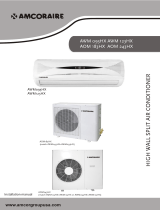
Step 3_START-UP COOLING AND MAKE ADJUST-
MENTS
Complete the required procedures given in the Pre-Sturt-Up
section before starting the unit.
Do not jumper any safety devices when operating the unit.
Do not operate the compressor in cooling mode when the
outdoor temperature is below 40°F (unless accessory low-
ambient kit is installed).
Do not rapid-cycle the compressor. Allow 5 minutes between
"on" cycles to prevent compressor damage.
COOLING SEQUENCE OF OPERATION
With the room thermostat SYSTEM switch in the COOL position
and the FAN switch in the AUTO. position, the cooling sequence
of operation is as follows:
1. When the room temperature rises to a point that is slightly
above the cooling control setting of the thermostat, the
thermostat completes circuit between thermostat terminal "R"
to terminals "Y", "G" and "O". These completed circuits
through the thermostat:
2. "O" terminal energizes Reversing Valve (RV) through Defrost
Board (DB),Note: The RV remains energized while the
Thermidistat J_'Ecooling mode is selected.
3. "Y" terminal energizes DB "Y". At_er 5 minute time delay of
DB terminals "TI" & "T2" has expired, ifLPS and HPS safety
switches are closed. Compressor contactor is energized start-
ing the compressor and outdoor tan motor,
4. "G" terminal energizes "BM" terminal of Integrated Gas
Control (IGC) and the indoor motor starts.
NOTE: Once the compressor has started and then stopped, it
should not be started again until 5 minutes have elapsed. The
cooling cycle remains "on" until the room temperature drops to a
point that is slightly below the cooling control setting. The
thermostat opens tbe circuit between thermostat terminal R to
terminals Y, O and G. Tbese open circuits de-energize contactor
coil C and BM of the IGC. Tbe outdoor and compressor motors
stop. After a 30-see. delay, the blower motor stops. The unit is in
a "standby" condition, waiting for the next "call for cooling" from
the room thermostat.
CHECKING COOLING CONTROL OPERATION (NON-ICM
UNITS)
Start and check the unit for proper cooling control operation as
follows:
1. Place room thermostat SYSTEM switch in OFF position.
Observe that blower motor starts when FAN switch is placed
in ON position and shuts down when FAN switch is placed in
AUTO. position.
2. Place SYSTEM switch in COOL position and FAN switch in
AUTO. position. Set cooling control below room temperature.
Observe that compressor, outdoor tan, and indoor blower
motors start. Observe that cooling cycle shuts down when
control setting is satisfied. The indoor fan will continue to ran
for 30 sec.
3. When using an auto-changeover room thermostat, place both
SYSTEM and FAN switches in AUTO. positions. Observe
that unit operates in Heating mode when temperature control
is set to "call for heating" (above morn temperature) and
operates in Cooling mode when temperature control is set to
"call for cooling" (below room temperature).
19
COMPRESSOR ROTATION
On 3-phase units with scroll compressors, it is important to be
certain compressor is rotation in the proper direction, To determine
whether or not compressor is rotating in the proper direction:
1. Connect service gages to suction and discharge pressure
fittings.
2. Energize the compressor.
3. The suction pressure should drop and the discharge pressure
should rise, as is normal on any start-up.
If the suction pressure does not drop and the discharge pressure
does not rise to normal levels:
1. Reverse any two of the unit power leads.
2. Reapply power to the compressor.
The suction and discharge pressure levels should now move to
their normal start-up levels.
NOTE: When the compressor is rotating in the wrong direction,
the unit makes an elevated level of noise and does not provide
cooling.
CHECKING AND ADJUSTING REFRIGERANT CHARGE
The refrigerant system is fully charged with R_IOA refrigerant,
tested, and factory-sealed.
NOTE: Adjustment of the refrigerant charge is not required
unless the unit is suspected of not having the proper R-410A
charge, The charging label and the tables shown refer to system
temperatures and pressures in cooling mode only.
An accurate superheat, thermocouple- or thermistor-type ther-
mometer, a sling psychrometer, and a gauge manifold arc required
when using the superheat charging method for evaluating the unit
charge. Do not use mercury or small dial-type thermometers
because they are not adequate for this type of measurement,
Refrigerant Charge-- Amount of refrigerant charge is listed on
unit nameplate (also refer to Table 1). Refer to Corporate GTAC
2-5 Charging, Recovery, Recycling, and Reclamation training
manual and the following procedures.
NOTE: Unit panels must be in place when unit is operating
during charging procedure.
1. No Charge- Use standard evacuating techniques. After evacu-
ating system, weigh in the specified amount of refrigerant
(Refer to Table 1),
2. Low-Charge Cooling- Using Cooling Charging Charts (Fig
20-25), vary refrigerant until the conditions of the appropriate
chart are met. Tbese charging cbarts are different from type
normally used. Charts are based on charging the units to the
correct superheat for various operating conditions. Accurate
pressure gauge and temperature sensing device are required.
Connect the pressure gauge to the service port on the suction
line. Mount the temperature sensing device on the suction line
and insulate it so that outdoor ambient temperature does not
affect the reading. Indoor air (CFM) must be within the
normal operating range of the unit.
3. Using Cooling Charging Charts- Compare outdoor-air tem-
perature (*F db) and the suction line pressure (psig) and
temperature with corresponding charging chart (See Fig.
20-25).





















